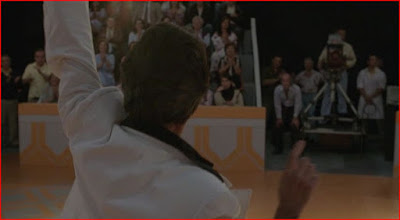 Chile in the early years of the Pinochet dictatorship is a desolate land. Dissidents are still being rounded up on the streets, while the common people seek hours of escape on television in the form of Festival, a sabadogigantic variety program with game-show elements and the cheery slogan, "A little money is better than none." One of its gimmicks is a weekly celebrity-impersonation contest in which the audience picks the Chilean counterpart of some famous foreigner. One week, it's the Chilean Chuck Norris; the next, it might be Julio Iglesias. But in the week we're interested in, Festival is looking for the Chilean Tony Manero, a native incarnation of the character played by John Travolta in Saturday Night Fever.
Chile in the early years of the Pinochet dictatorship is a desolate land. Dissidents are still being rounded up on the streets, while the common people seek hours of escape on television in the form of Festival, a sabadogigantic variety program with game-show elements and the cheery slogan, "A little money is better than none." One of its gimmicks is a weekly celebrity-impersonation contest in which the audience picks the Chilean counterpart of some famous foreigner. One week, it's the Chilean Chuck Norris; the next, it might be Julio Iglesias. But in the week we're interested in, Festival is looking for the Chilean Tony Manero, a native incarnation of the character played by John Travolta in Saturday Night Fever.One Manero-wannabe is Raul Peralta Paredes O, who at age 52 is perhaps the most unlikely candidate. His case seems the more hopeless when he shows up at the TV studio a week ahead of time. He gets to register for the Manero contest, at least, and when asked his occupation he simply says "This," meaning "show business." He does a Manero impersonation and serves as a sort of director of a Fever-inspired floor show at a local bar with bigger aspirations. In his free time he watches the movie obsessively, memorizing Travolta's English dialogue during the Spanish-subtitled film, and he dreams of installing a glass dance floor like that in the movie in the bar. As far as his Manero mannerisms go, the spirit is willing, but the legs are weak. But he has no higher ambition than to become Tony Manero -- though he does have some lower ambitions.
So far, so Scorsesean. Raul is one of those obsessive, monomaniacal losers who manage to make big breaks for themselves in moments of insane inspiration or pure violent passion. But director Pablo Larrain and his co-writers take the Scorsese formula to a fresh extreme. In Taxi Driver and The King of Comedy there's a slow burn before the madman's desperate outburst. In Tony Manero it's established early that Raul is a madman and a murderer. We see him witness a mugging from his window and rush downstairs to aid the victim. He helps her home and notices her color TV set, while she offers him some expired cat food as a reward. Then he beats her to death with his bare hands.Idol and idolator: Alfredo Castro (below) looks up to John Travolta (above) in Tony Manero.
He'll later trade the TV to pay a shady junkman for the increasingly expensive glass tiles he'll need for his dance floor. Everything is a means to the end of his hoped-for transfiguration into Tony Manero. Saturday Night Fever becomes a religious experience for him, if not something more pleasurable. Raul may be having some midlife crisis of sexuality that he doesn't comprehend. His girlfriend complains that he can't get it up anymore, except when he thinks of his new dance floor. He's traumatized when Fever is replaced at the local bijou with another film starring "the same gentleman," called Brilliantina. It just isn't the same. In his grief he sneaks into the projection booth and beats the projectionist and manager to death. He then finds the precious reels of Saturday Night Fever and takes them home to inspect frame-by-frame.
You should be dancin'. Yeah.
You get the idea by now. There might be some suspense over whether Raul will be caught before the Festival show, except that Larrain establishes fairly early that law enforcement is more interested in tracking down dissidents than in catching real criminals. You get no sense that anyone's even aware of a murder spree going on. The only pressing questions are whether Raul will win the Manero contest and how many more people he'll have to destroy before then.
There's no point in analyzing why Raul responds to Saturday Night Fever the way he does. You either accept that he's barking mad or that his situation is somehow symbolic of Chile's plight under Pinochet. There's nothing wrong with a film about a madman, of course, and as Raul co-writer Alfredo Castro convincingly portrays a person who isn't flamboyantly or whimsically mad but selfishly compulsive to the point of complete ruthlessness. Larrain finds the right milieu for him in the drab, seedy locations, and contrasts those effectively with the tacky fantasia of the Festival studio set. I think Larrain's intent is ultimately satiric; otherwise he might have made the killings more gory and the film itself more of a horror movie. It's horrific enough as is, as a portrait of the kind of monsters a society like Pinochet's Chile might create.
Here's an English-subtitled trailer, uploaded to YouTube by NetworkReleasing.






No comments:
Post a Comment